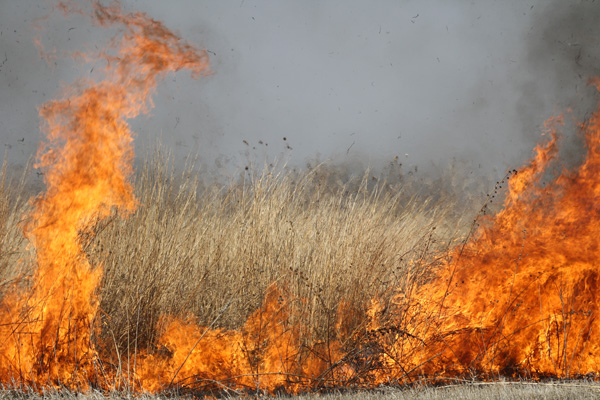Population trumps climate and carbon in shaping the future of wildfires
Patterns of urbanization, not just growth, affect acres burned
May 23, 2016 - by Staff
May 23, 2016 - by Staff
May 23, 2016 | All other things being equal, a warming climate would likely expand the amount of land scorched each year by wildfires across the globe.
But all other things aren't equal.
A new study by a team of scientists, including Leiwen Jiang at the National Center for Atmospheric Research (NCAR), found that the future pattern of population growth, not climate change, is likely to be the dominant factor in determining whether the amount of land burned by fires increases or decreases this century.
Jiang and his colleagues — Wolfgang Knorr of Lund University in Sweden and Almut Arneth of the Karlsruhe Institute of Technology in Germany — also found that the anticipated increase in total burned area due to a warmer climate will likely be offset by the carbon dioxide itself, which can act as a fertilizer, affecting plant growth and driving down fire risk globally.
When climate change, carbon dioxide concentration, and population are all considered, the total area burned across the globe could very well decrease over the rest of this century, according to the study, published in the journal Nature Climate Change.
"You cannot look at the impact of climate change alone to predict future wildfire risk," Jiang said. "You have to put population changes in the model, and not just population size, but also spatial distribution. There is a big difference between population growth in rural areas compared to urban areas."

A wildfire burns across a Kansas grassland. On average, grassland fires account for 70 percent of the global land area burned each year. (Photo courtesy U.S. Fish and Wildlife Service.)
Climate change generally increases global fire risk by drying the fuel — trees, grasses, and other vegetation — that feeds the flames.
At the same time, the additional carbon dioxide in the atmosphere tends to decrease global fire risk, largely by encouraging the growth of shrubs in areas that are now grasslands. On average, more than 70 percent of the total area burned each year across the world is on grassland savannah, where fire can spread very quickly. As shrubs encroach, they fragment the grassland and create natural firebreaks.
People, on the other hand, have a complex effect on fire risk. "People not only act as fire igniters, but they also act as fire suppressors," Jiang said.
In general, humans suppress fires more than they ignite them, leading to an overall downward trend in acres burned when population increase is considered on its own, the study found. This helps explain why global burned area has actually decreased over the last century, despite a warming climate, Jiang said.
In the future, however, the way population growth is distributed across rural and urban areas will have more of an impact on future fires than total population growth alone. The pace of urbanization also has a different effect, depending on the region of the world.
For example, in densely populated parts of sub-Saharan Africa, a future with generally low population growth but fast urbanization could lead to a decrease in average area burned annually, from about 39,000 square miles (101,000 square kilometers) between 1971 and 2000 to about 30,000 square miles (78,000 square kilometers) between 2071 and 2100.
Conversely, relatively high population growth with a slow rate of urbanization would lead to an increase in annual burned area from about 63,000 square miles (101,000 square kilometers) to about 75,000 square miles (194,000 square kilometers) over the same time periods. Both scenarios assume that greenhouse gas emissions continue unabated.
In other regions of relatively high population density, the study finds that total burned area increases regardless of urbanization patterns, but the scale of the increase varies.
For example, in heavily populated parts of Asia, North Africa, Latin America, and the Caribbean, a scenario of low population growth and fast urbanization would lead to an increase in average burned area annually from 21,000 square miles (55,000 square kilometers) to 23,500 square miles (61,000 square kilometers). However, high population growth coupled with slow urbanization would drive an even greater increase, to 33,600 square miles (87,000 square kilometers).
Regardless of the population scenario, the new study does not project a large future increase in burned area. Instead, it shows that the total area burned by wildfires globally could further decrease this century or perhaps increase to levels seen in the late twentieth century, depending on future population growth patterns.
"This study underscores how important it is to consider demographics as we measure the future impacts of climate change," said Jiang. "The way our population grows will have impacts far beyond wildfires, and may determine how resilient society is in the future."
W. Knorr, A. Arneth and L. Jiang, Demographic controls of future global fire risk, Nature Climate Change, DOI: 10.1038/nclimate2999
Writer/contact
Laura Snider, Senior Science Writer and Public Information Officer
Collaborating organizations
Lund University, Sweden
Karlsruhe Institute of Technology, Germany
Funder
European Commission